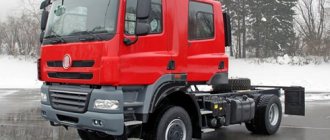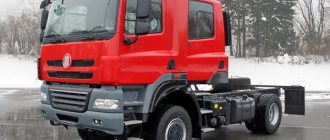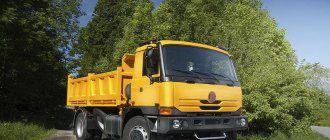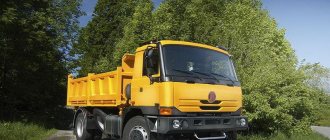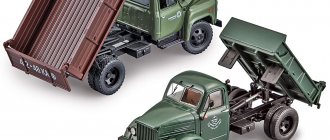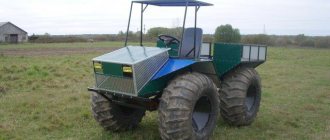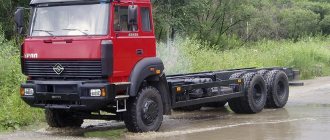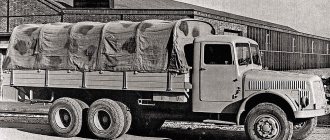Tatra Phoenix T158-14
Seven-axle Koschey Tatra
Vladimir Chekhuta, photo TATRA TRUCKS as
The history of the Czech company TATRA is reminiscent of the saga of Koshchei the Immortal. The ascetic made of bones did not want to die: he was skinny, unsociable, lived on the outskirts and gave rise to myths about himself. Tatra's branded air-cooled diesel engines are hardly relevant now, but its trucks continue to survive due to their unique skeleton - this backbone frame.
Over the course of their entire life, Tatra trucks have already been predicted by evil tongues to die suddenly five times and forgotten into oblivion at least three times. But the brand also survived the German occupation, the post-socialist apocalypse and cartel conspiracies. Particular attention has been focused on the brand in the last 20 years, when the company was losing markets, but this did not reduce interest in it.
The company's locus in the global automotive industry was determined by its scale and the palisade of legends behind which the company sits like a fortress wall. How many other producers in socialist countries, having discovered the world market in the 1970s, died within a couple of decades in agony from the shock of future prospects. ZIL production closed in Moscow, Romanian ROMAN disappeared, Czech LIAZ became a metaphor and few people will remember the rapid funeral of Star, Jelcz and Praga. And somewhere at the foot of the Beskydy Mountains they can’t even breathe: they are forging new items in their castle, one after another!
At the recent premiere of the multi-axle chassis, TATRA TRUCKS as made everyone remember that it is the No. 1 manufacturer of trucks among all automobile companies in the socialist bloc: in Kopřivnice 120 years ago they made the first goods truck and only half a century later the public recognized it as a world event! That truck looked like a trackless carriage. It was Tatra that began the serial assembly of unified 4- and 5-axle vehicles in the 1980s. Such designs were then produced in the socialist bloc only by highly specialized enterprises for military purposes (MZKT (“Volat”), KZKT (“Rusich”), or for crane chassis (Polish BUMAR and fellow “Yanvarets” of the Odessa plant). The difference between the Czech ones was that that its conversion versions (i.e., transferred from the category of militaristic developments) easily fit into road dimensions and met civilian requirements for axle loads.
Recently, multi-axle chassis, as a rule, are ordered by oil and gas companies for the installation of specialized equipment (swabbing, exploration crane-drilling rigs, etc.). But even they have to meet road requirements of an overall width of 2.5 m and a height of 4 m.
Tatra Phoenix T158-14, ordered by a buyer from Israel, is intended for the installation of a special heavy-duty crane-manipulator unit (CMU) manufactured by the Turkish company World Power Erkin Company Limited.
As reported by the customer service, the special vehicle being created will be the carrier of a 150-ton Erkin ER-455.000 L-8 crane with a telescopic boom without pulleys (this is how cranes differ from boom truck cranes, they do not have cables). The new vehicle with enormous capabilities will be used for loading and unloading super-heavy and indivisible general cargo. Considering the capabilities of the Czech automobile chassis for working on difficult terrain, it can be predicted that the 7-axle Tatra-Erkin crane will be used in difficult areas where delivery of a multi-axle telescopic truck crane will cause great difficulties.
The Tatra chassis is built with a 14x12 drive configuration. As can be seen from the illustrations, axes 1, 2, 6 and 7 are controlled. They are equipped with air suspension and allow a load of 9 tons each. The middle 3rd and 4th axles with a load capacity of 13 tons are equipped with air suspension in combination with springs, which appeared on the Tatra Phoenix more than 10 years ago. The fifth non-drive axle is designed for a load of 11.5 t. Thus, the total weight of the chassis reaches 73.5 tons!
The three main central axles (3, 4 and 5 axles) are equipped with dual-pitch tires and equipped with 315/80 R22.5 tires. All other steering axles received pneumatic tires 385/65 R22.5. The steering of the front axles is carried out by a ZF monoblock with an auxiliary hydraulic cylinder, and the rear axles are controlled by the VSE electronic-hydraulic system.
The new TATRA Phoenix chassis is equipped with a 12.9-liter MX-13 PACCAR engine with a power of 390 kW (530 hp), meeting the requirements of the Euro 6 environmental standard. The engine is coupled with a 16-speed ZF Traxon automated gearbox with an intarder. In addition to European drive units, the Czech truck received a cab from the DAF CF Euro 6 model range, and the entire set of components supplied by the Dutch automaker. The chassis design of the new truck is quite typical for Tatra and is based on the original tubular frame, which is already a signature feature of the Czech company.
The technology using the T158 series tubular frame makes it quite easy to add the required number of bridge units with swinging axle shafts and mount a mounting frame on top of it, on which the crane-manipulator installation will be mounted. Large strokes of axle shafts with pneumatic elements on the front and rear axles, as well as a rigid additional spring suspension, make it possible to compensate for the bending moment of the transmission backbone frame, reduce the load when the mounting frame is misaligned and allows you to evenly distribute the load on each wheel on uneven surfaces.
“Eight by eight” (Tatra Terr№1)
T. Lysov, photo by the author
Terr№1 - the basis of the “civilian” model range of Tatra AS - has been in production since 1998. These are two-, three- and four-axle construction chassis (wheel formulas 4x2, 4x4, 6x4, 6x6, 8x8), truck tractors and dump trucks. Cars work both on roads with smooth surfaces and in off-road conditions. There are several options for ground clearance - from 235 to 300 mm. Depending on the modification of the Terr№1 chassis, it can carry from 16 to 28.1 tons of cargo.
The design of Terr№1 is in keeping with the Tatra traditions: independent torsion bar front suspension with swing axle shafts, rear suspension with air springs (with built-in springs or complete with springs); short, extended or crew cab with the "815" frame, but modified design. The basic equipment of all options includes interwheel and center differential locks, which are so scarce in the Russian automotive industry; ABS is additionally installed.
Cold, warmer, hot
It's exactly seven in the morning. We - me and Mikhail Ignatovsky - are leaving the UM-25 gate of MSM-5 JSC. There is a whole working day ahead and about 300 km of driving through city streets and construction sites, which have been drowning in a mess of mud and sleet for several days. It's -5°C outside. Thoughts about a cabin frozen overnight: “icy” seats, 20...30 minutes to warm up, and a week-long course of home medicine: Apparently, these thoughts were reflected on my face. “Yes, sit down, it’s warm here,” Mikhail encourages.
Indeed, it is warm, and after the street “minus” it is even hot. Heater? No, climate control. In addition to “good weather”, the cabin has comfortable seats with velor upholstery and air suspension, and a music system. All this is perceived somehow immediately, and a little later I begin to look around.
The quality of fit of plastic panels has increased significantly even in comparison with what could be seen on Jamal dump trucks. Above the windshield there is a shelf with a “blind” niche for newspapers and papers and several boxes. The instrument panel contains a minimum of keys and switches, only control units for climate control and operating modes of the transfer case. Exterior mirrors are heated and electrically adjustable.
While the car clocks up “zero” kilometers, I take a closer look at the driver’s performance. The left steering column switch contains almost all imaginable functions - turn signals, high-low beam headlights, and windshield wiper control: Mikhail says: convenient. But the right steering column switch, which controls the engine brake, seemed flimsy, really, no thicker than a toothpick. The driver confirmed my doubts. Mikhail became convinced of its low durability while still working for Jamal, from which this solution migrated to Terr#1. He only slightly overdid the effort, the consequences of which, you see, on a truck operating on roads of poor quality, will not take long to come. The only thing that seemed unexpected to me for a car with a factory price of more than $100 thousand was the absence of electric windows and air deflectors at the feet of the passenger-shift passenger.
Overall, the interior of the Terr#1 cabin makes a very pleasant impression. The engine running at idle speed transmits noticeable vibration to the steering wheel and seats, but in general the level of noise and vibration insulation of the cabin is quite high - it is noisier in the Bychka. Mikhail adds: “As a plus, you can remember the spaciousness of the cabin, the height of the ceiling - you can sit here even with a top hat on your head.”
| The cabin is located high, but the landing is comfortable |
Tatra Terr№1 8×8 began service in UM-25 of the capital’s “fifth Mosstroymekhanizatsiya” in May 2003. As the only one of its kind, this vehicle was handed over to the management of Tatra AS for testing - to study the behavior of the vehicle in operation and, ultimately, market performance promotion. After all, nothing can play to the benefit (or vice versa) of a car’s image more than the results of long-term tests under real operating conditions. According to Sergei Morozov, head of the Tatra service department, Terr No. 1 has serious advantages over three-axle dump trucks: the vehicle transports more cargo during a work shift. So far there are no problems with its operation. But in the future, a very serious counterargument to its use may be the tightening of restrictions on permissible axial load.
By the time of our trip together, the car had covered about 30 thousand km. The ratio of roads with smooth surfaces and off-road conditions (quarries, landfills, construction sites, etc.) balances at the “fifty-fifty” level. Terr№1 is used exclusively for the transportation of bulk cargo. Large concrete fragments are not her profile. They can damage the walls of the body or tear off the tailgate during unloading. Or both at once. To transport such cargo, the department uses Volvo FH12 tractor units with tipper semi-trailers.
| The essentials are on the dashboard |
Czech “builders” are respected in management. In the coming months, UM-25 will receive another batch of TerrNo. 1 dump trucks. But these will no longer be four-, but three-axle cars, but certainly with an all-wheel drive transmission.
Terr No. 1 in the big city
From the Southern District of Moscow we go to the city of Dzerzhinsky (this is about 30 km), from there, loaded with 25 tons of sand, we return to the city. And so - 3 times, for a total of six trips with a load. Mileage per day – 230 km. This is slightly less than the average daily mileage, which is 300...400 km in Moscow and the near Moscow region. But on the day of our trip, the average speed of traffic flows dropped sharply due to the sharply worsening weather.
The clock hands mark the beginning of nine, we are leaving for the Moscow Ring Road. In the far right rows are sleepy truck drivers from the regions, on the left are kamikazes fidgeting from side to side, having not had time to change summer tires to winter ones... But there is not a hint of excitement on Mikhail’s face. Our dump truck, equipped with a 12.7-liter turbodiesel V-8 (Euro-2) with a power of 408 hp, confidently picks up speed, and pretty soon the speedometer needle hangs at 80 km/h. “Another ten from above,” explains Mikhail, “and that’s it, the limiter will work.” But such speed is useless. More importantly, and you will also be convinced of this, that at maximum load the engine “fades out” only a little. – I willingly believe Mikhail, watching the next overtaking. He continues: “In general, if we are talking about driving in the city, Terr No. 1 is a very successful car - visibility is good, the steering and pedals are light, the brakes are obedient, with ABS; Well, all-wheel drive is all-wheel drive: the Czechs have this from God. By the way, I connect the front end only on dirt roads and icy roads, and on wet asphalt it is basically not needed. All transfer case modes are activated not by levers, like ours, and not by a scattering of keys, like in Volvo or Scania; There are only three buttons for axles and differential locks.
| Mikhail: Where you steer, you go there |
When driving on city streets, TerrNo. 1 requires some fine work on the steering wheel - this is not a small car. Mikhail easily fits into right turns into tight streets. In addition to the large turning radius in the city, Terr No. 1 is hampered by its frankly stiff suspension. And if you notice small irregularities only with your eyes, then you already feel serious bumps and potholes with the entire contents of your stomach. And the air-suspended seats don't help here.
It's great that the car attracts attention. Throughout the day, Terr№1 attracted many glances - men, children and women were staring at the only Czech “octopus” in the Russian Federation! A striking example: at an intersection a four-axle MZKT dump truck approaches us. The driver gesticulates vigorously: they say, let’s wave without looking? Mikhail hardly reacts: “The car is wonderful. And man is an inquisitive creature.”
It seems that if it weren’t for the huge body and almost a dozen huge wheels, Terr No. 1 from the UM-25 would not have aroused such interest. After all, there are no headlights with gas-discharge lamps on it, and the design of its cabin cannot be called intricate.
We stop at a sand quarry near Dzerzhinsky. Under the wheels there are ruts 20...25 cm deep, wet sandy soil, fragments of concrete slabs and other construction debris. An unpleasant creaking noise suddenly sounds under the cabin floor (like a fork on a plate). “I connected the front end,” comments Mikhail. We're heading uphill. The wheels of the front and rear bogies alternately slip, but the car, without losing directional stability, confidently continues to move. “Wherever you steer, that’s where you go,” explains Mikhail.
| Mechanical gearbox, with divider |
We line up for loading - behind Scania C-class and Volvo FM12 dump trucks from 1998 and 2001 - and wait for our turn. Scania, having accepted the load, sets off from the platform and, after menacing throttle changes, takes the climb “on the fly” - at speed. One of the Volvo dump trucks begins to turn, but unsuccessfully - the wheels of the drive axles slip, and the truck itself begins to turn. Another two or three meters and there’s a slope. But everything works out by “swinging” for 10 minutes. A few more minutes and the line moves forward. Finally, Terr#1 is sent for loading.
The excavator loads the body with sandy soil up to the sides. According to Mikhail, this is approximately 24...25 tons. Loading is completed, and we leave the site without any fuss - the car runs like it’s on asphalt! I put away the notebook - there is nothing to write down, no comments. It is clear that in terms of cross-country ability, Terr No. 1 and Swedish cars differ in the same way as the wheel formulas 8x8 and 6x4. Therefore, UM-25 often uses Volvo and Scania where it can save on cross-country ability.
We are back on the Moscow Ring Road. The “temperament” of the loaded dump truck has cooled down somewhat, but there is no talk of a lack of power - with the same calmness, Mikhail overtakes trucks traveling at a speed of 50...60 km/h. By the way, according to him, the Czech V-8 is quite economical - Terr No. 1 travels 600...700 km on one “tank” (its capacity is 320 liters).
The unloading location is not far from Varshavskoye Highway, a small courtyard in a U-shaped complex of new residential buildings. You have to turn around and reverse to the site in far from the best conditions: on the one hand, a bulldozer is scurrying back and forth, on the other, old ZILs are standing nose to nose. But you don’t have to look out of the window or hang in the doorway - everything is visible in the mirrors. I monitor the unloading: Mikhail pulls a small lever to the left of his seat, and the body (VS-mont, Slovakia, capacity 16 m3) begins to slowly rise. Thanks to its “faceted-oval” shape, nothing remains inside it except a few kilograms of “polyps”. Now the body will accept 23 tons of crushed construction waste, and we will again go to Dzerzhinsky - to the landfill, which is not far from the quarry.
By noon we arrived at our destination, then returned to Moscow. After lunch, two more trips along the same route and return to base. And then it’s five o’clock in the evening, the end of the working day. I ask: – Mikhail, your working day is over. What does it feel like? Are you very tired? - What are you doing? What kind of fatigue? There was no reason to get tired here. When I was working on our trucks: – Mikhail seemed not to hear me and enthusiastically developed a conversation about “ours”, radiculitis. And also about chaises and railway cars that were once assembled at Tatra AS, about the biography of the famous engineer Hans Ledwinka: - Under such operating conditions, Terr No. 1 has more advantages than disadvantages. Powerful engine, all-wheel drive, spacious cabin. But without what could this dump truck not become a “wonderful” machine, as you say? “Without all-wheel drive,” Mikhail answers without hesitation. - Yes, “eight by eight” is an ace...
About technology
| Loading 23 tons of crushed construction waste |
Terr№1 - the basis of the “civilian” model range of Tatra AS - has been in production since 1998. These are two-, three- and four-axle construction chassis (wheel formulas 4x2, 4x4, 6x4, 6x6, 8x8), truck tractors and dump trucks. Cars work both on roads with smooth surfaces and in off-road conditions. There are several options for ground clearance - from 235 to 300 mm. Depending on the modification of the Terr№1 chassis, it can carry from 16 to 28.1 tons of cargo.
The design of Terr№1 is in keeping with the Tatra traditions: independent torsion bar front suspension with swing axle shafts, rear suspension with air springs (with built-in springs or complete with springs); short, extended or crew cab with the "815" frame, but modified design. The basic equipment of all options includes interwheel and center differential locks, which are so scarce in the Russian automotive industry; ABS is additionally installed.
In the engine compartment is a well-deserved 12.7-liter turbodiesel V-8 of its own design. Well known for the Jamal 815 cars and dump trucks, it is equipped with direct fuel injection, an intercooler, and is free of electronics.
The editors express their gratitude to UM-25 of MSM-5 CJSC and personally to S.E. Morozov (head of the Tatra service department) for organizing the trip.
